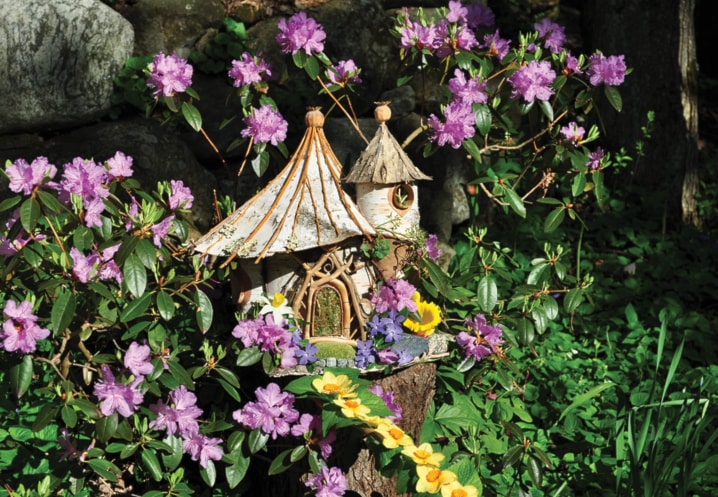SEATTLE — I feel like Alice in Wonderland. Sprinting past an alligator drinking a soda pop and a T-Rex playing guitar, I lean toward a family of colourful metal toadstools that come to my knee.
“Aren’t those great?” asks Jim Honold as he ushers me through a forest of recycled oil drum statues at his Home & Garden Art store.
I’ve come to this Disneyland for gardeners seeking inspiration for easy ways to add whimsy to gardens, and Honold is giving me the rundown.
“Adding art to your garden is an extension of your identity,” he says as we brush past a murder of concrete crows. “You decorate the inside, why not the outside? Any personality, any hobby, can be represented — classical, funky, seasonal — you name it.”
Looking around, it appears he’s right. There’s the giant metal umbrella coat-stand for a classy infusion of humour; a multitude of hobby-inspired birdhouses; three-metre metal lobsters for fishing enthusiasts with no attachment to subtlety; and an old tricycle planter box aimed at the nostalgic set.
Everywhere, whimsy abounds.
But how do you actually start adding lawn art to an outdoor living space?
“Instead of throwing stuff in the attic or garage, put it out in the open,” Honold says.
He suggests displaying old garden tools, metal toys, or wine glasses and decanters. Chipped plates can find new life in concrete stepping stones, and wooden kid-size furniture always adds a nice touch.
“Focus on what’s readily available or representative of your area,” Honold adds. “Coastal areas might have fishing nets and glass floats, and places close to rural communities will have farm equipment.” In Washington state, he says, “people bring us old saws and ask us to laser-cut their name or address on them.”
For a big splash, Honold recommends an artistic gate. Whether installing custom wrought-iron doors with elaborate scenes on them or simply taking a can of bright red paint to a basic home-store model, gates can reflect personality and set the tone for the rest of the house.
“Think about all the things a gate can say,” Honold says. “‘Stay out!’ or ‘We’re fun people!’ ”
If the message you’re trying to send is “We’re magical,” find ways to add fairy elements to your garden. For kids and anyone with more than a passing fancy for Harry Potter, there’s nothing quite as charming as coming across traces of pixies in the yard.
Greenspirit Arts’ Sally Smith knows the power of a good fairy house. She creates high-end custom ones in her studio in Wadhams, N.Y., that have inspired a calendar and greeting card line.
While most of her houses aren’t made for extensive outdoor use, she says her calendars and online tutorial often serve as inspiration for people to create their own more durable models.
“Making a fairy house is something we all innately know how to do because of the child in us,” Smith says.
For a do-it-yourself fairy house that can stand up to the elements, Smith suggests working with stone as a base, and attaching a stick and moss roof and a wooden door. Decorations can be found objects — beach glass, pine cones, welcome mats woven from grasses or pine — even tiny dollhouse furniture.
And what about the garden itself?
“Plant choices can add whimsy to the garden as well, or simply complement the art you’ve chosen,” says New Albany, Ohio, landscape designer Nick McCullough.
He suggests incorporating climbers like clematis, honeysuckle, roses or golden hops to vertical art and trellises, then adding lower plantings at the base.
“Climbers add a mystique to the garden,” McCullough says. “They make the garden feel established.”
For other art, McCullough recommends thinking about scale and complementary colours.
“If you’ve got a bunch of pink flamingos, you could go big and bold,” he says, suggesting plants like catmint, Rozanne geraniums, Phormium Pink Stripe and torch lilies to surround the birds and “add a taller, architectural element.”
For smaller pieces, such as fairy huts or little figurines, lay down a base of moss in a small, shallow trough. Thyme, armeria, succulents and sedums also offer a great base for delicate art, and can provide a border to a bed of pebbles and coloured marbles — a touch sure to delight children.
Colourful bursts can be achieved with black lace elderberry, dahlia “Knockouts,” coleus and canna, among other plants. Canna “Tropicanna” and King Tut Papyrus offer a bold structural base.
“There’s no right or wrong way to do it,” McCullough says. “Gardens are so personal — you can use them to express yourself in any way.”
